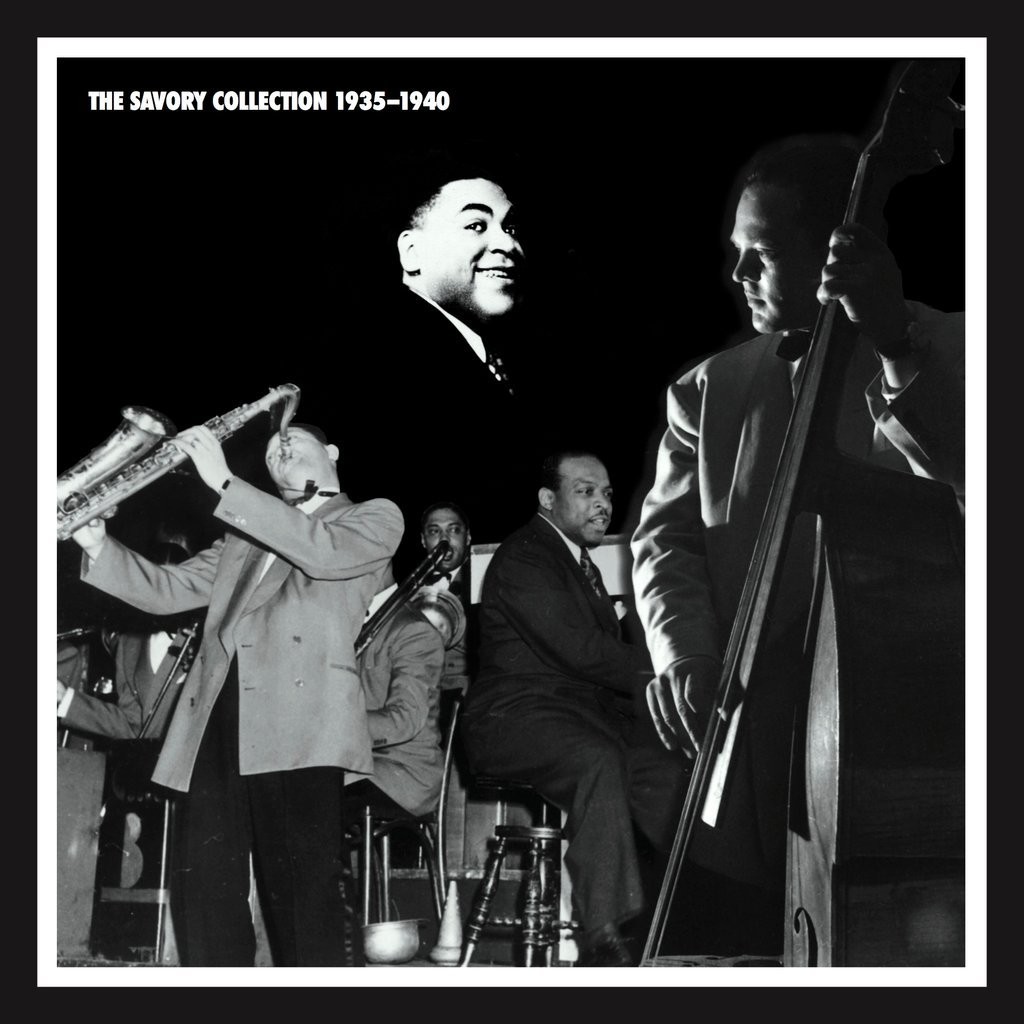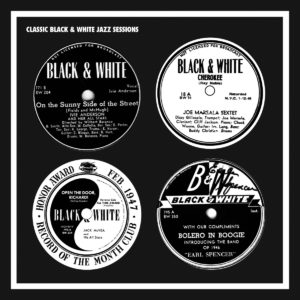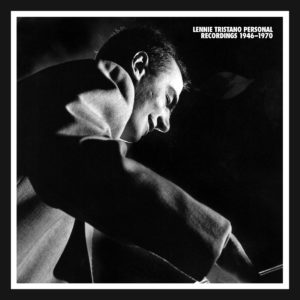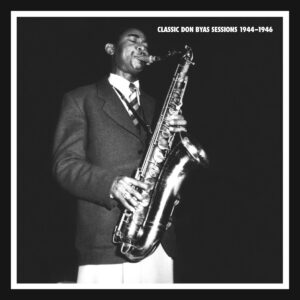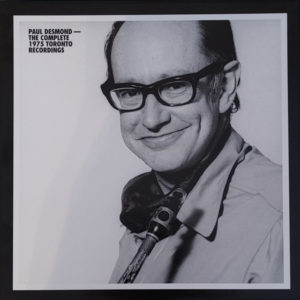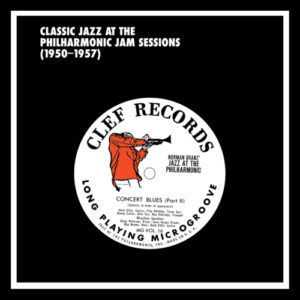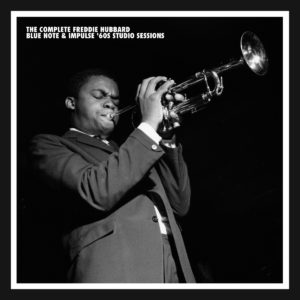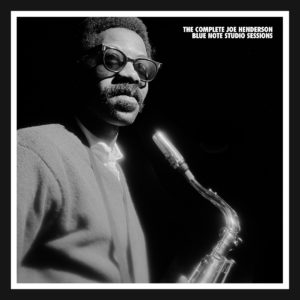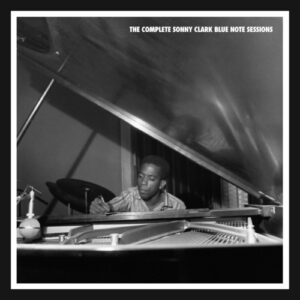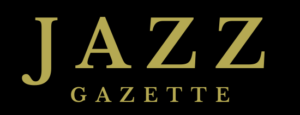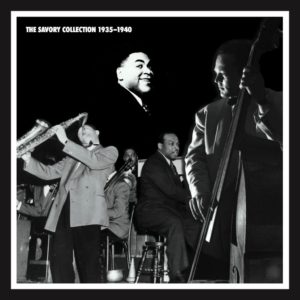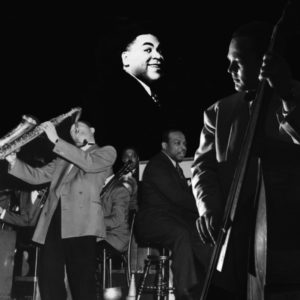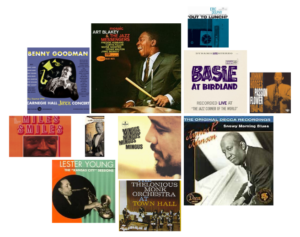
“Imagine finding an unknown play by Shakespeare or an unknown novel by Mark Twain.
That’s what this is.”
Six CDs with 108 tracks locked away for more than 70 years and finally available on CD for the very first time anywhere! Broadcast material professionally recorded onto lacquer discs and aluminum discs by Bill Savory and lovingly restored by the pre-eminent restoration engineer Doug Pomeroy.
“Then came the shock of my life! Could it be? Basie, then Fats Waller, Ella Fitzgerald, Coleman Hawkins, and that was just in the first couple of boxes! The discs were mostly aluminum – that was unusual – and in varying states of decomposition, but some were absolutely pristine. Gene asked if I would like to take a few discs back to New York to sample. I managed a seemingly disinterested “Well, if you’d like me to”, grabbed a handful, including an unblemished 12” Basie Honeysuckle Rose and got out of there before he could change his mind” – Loren Schoenberg, National Jazz Museum of Harlem
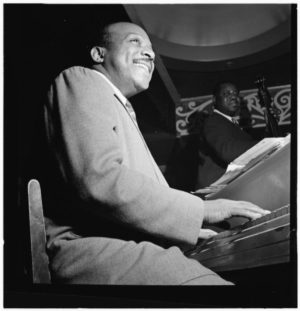
Our Most Momentous
Release In Years!
For Loren Schoenberg of the Jazz Museum of Harlem, it’s the discovery that capped nearly forty years of searching. For us at Mosaic, it’s the “find” that has us re-examining an era we thought we knew inside out.
And now, for listeners, it’s an historic and fleeting opportunity to own a treasure trove of previously unknown music.
Mosaic Records presents “The Savory Collection” – six CDs with 108 tracks locked away for more than 70 years and finally available on CD for the very first time anywhere. The recordings are from the personal collection of Bill Savory, a quirky and secretive studio engineer in New York whose day job in the late 1930s and early 1940s was transcribing radio broadcasts for foreign distribution, and whose nighttime passion was turning on the disc recorders to pull in and preserve what was happening in the clubs of New York City and other cities.
Hidden Away. Until Now!
It was an era when TV didn’t exist yet, live music was everywhere, and radio stations would serve it to their audiences – in what everyone thought were once-in-a-lifetime experiences. But no one counted on a guy like Bill Savory being on the other end of a radio signal.
Savory had always been cagey and unresponsive when asked about his collection. There were rumors it contained jewels. We’re here to report – it does:
• Thirteen tracks from the original, under-rated John Kirby sextet featuring some of the finest soloists of the day: Buster Bailey, Charlie Shavers, Russell Procope, Billy Kyle and O’Neill Spencer.
• Chick Webb, Ella Fitzgerald and Roy Eldridge as guest stars on the CBS radio hit of the day “The Saturday Night Swing Club”.
• Broadcasts from the legendary Café Society, Famous Door, Panther Room, Onyx Club and regularly scheduled radio programs with a cream of jazz stars.
• Joe Sullivan improvising at the piano – solo — during a private party. A chance for him to loosen up, stretch out, and experiment.
• And an unknown version of “Body and Soul” by Coleman Hawkins, recorded live just seven months after his earth-shattering recording in 1939 that most listeners believe laid down an entirely new point of view about jazz soloing. As important as that original recording was, this newly-found version might be EVEN BETTER.
• A wealth of classic Count Basie live when Lester Young, Herschel Evans and were with that classic, trendsetting orchestra making jazz and big band history.
The Sound of a City
Most recordings in the collection were from dates in New York, the center of the world in jazz in that era. Other recordings in this collection were from clubs in Boston, Asbury Park, and Chicago, or from the radio studios of WNEW, CBS and NBC.
Swing was still a significant factor, but the earliest strains and seeds of bebop were being planted. Everything was happening at once. At clubs such as Café Society, the Savoy Ballroom, and the Onyx Club. Or at a place called the Fiesta Danceteria on 42nd street, “the world’s first self-service nightclub,” where Hawkins topped his own recording of “Body and Soul” in a performance that was never meant to be immortalized. It was just a night like any other night, and there was magic every night.
Imagine Count Basie at the Famous Door with Lester Young, just three years after Lester’s recording debut. He was first heard on songs such as “Boogie Woogie” and “Lady Be Good” with Basie, and here he was performing them live. And alongside him was Herschel Evans, whose talent can now be reassessed.
Or, revel in the showmanship and exuberance of Fats Waller from a place called The Yacht Club, where the fun and frivolity of a casual club date takes you deep in the world of these men and women who did this night after night.
You couldn’t see it at home – or Savory from his recording studio — but you can imagine the spotlight hitting the microphone and Ella Fitzgerald or Mildred Bailey stepping into the light to hold a room – and a radio audience – in their hands.
The Sound of an Era
Those artists are all here on the Savory collection, along with Teddy Wilson, Albert Ammons, Benny Carter, Bobby Hackett, Chick Webb … the list goes on and on.
Savory’s achievement in recording and preserving this material can’t be overstated. You could be at home around your radio, but you didn’t have the equipment in the studio where Savory tinkered and invented. The glory of these broadcasts in many cases heard here is that he was capturing live music without the limitation of a 3 or 4 minute 78 rpm recording. If the club version of a song went for six minutes, no matter. Savory got every note of it.
Audio Clips & Session Notes
Coleman Hawkins & His Orchestra
Body and Soul
We start with the piece de resistance, so entrancing to the critical community when its discovery was announced in August 2010 that it ended up on several of the “Best Recordings” of the year.
Coleman Hawkins (1904-69) single-handedly created the idiom for the tenor saxophone in jazz. Before he came to maturity, however, Sidney Bechet and Adrian Rollini had already taken giant steps on the soprano and bass saxophones respectively, establishing the idea that the saxophone could be used to make great jazz. It was left to Hawkins to process the innovations of Louis Armstrong in an intensely personal way, and fashion out of them his own voice.
There are very few musicians in any genre that remained protean figures for as long as Coleman Hawkins did. When he gave up the cello for the saxophone in the early 1920s, not only was his chosen instrument considered a joke at best, there was as yet no model for coherent jazz improvisation. Miraculously, at the age of 35 he would have a hit recording that remains one of the most sophisticated and challenging creations ever to come remotely near the best-seller’s list. And by the age of 59, Hawkins would more than hold his own in studio encounters with John Coltrane and Sonny Rollins – both of whose careers would have been unimaginable without Hawkins’ precedent.
We defer to saxophone virtuoso James Carter for his reflections on the 1940 tunes captured from New York’s Fiesta Danceteria, which, according to the announcer was “the world’s first self-service nightclub!” What we hear here is proof positive of Hawkins’ decision to play music the way he wanted to, with an extended instrumental solo of unbridled brilliance.
For us aficionados of Coleman Randolph Hawkins, his name is synonymous with the Rosetta Stone of tenor saxophone recordings: none other than the October 11, 1939 studio recording of Body And Soul!
In this 1940 outing with his big band in tow, Hawkins sees his previous two choruses and ups the ante by playing an additional two choruses to boot building on an already rock solid blueprint of sublime tenor chanting! In Hawk’s extended reading, I hear familiar quotes from ’39 but he’s not resting on the laurels of a successful recording because he continues to challenge himself by using the two additional choruses to gain swinging momentum. – James Carter
Liza
Saturday Night Swing Club Studio Orchestra
With Roy Eldridge And Chick Webb
What’s interesting is hearing Chick Webb play on Johnny Williams’ drums. Chick tuned his snare drum and bass drum much lower than Johnny. Because of the lower tuning, it can sometimes be hard to hear some of the great things Chick played.
On this track, you really get a chance to hear not only the power and drive that he had, but his clean snare drum articulation. The two of them are like lighting a match to gasoline; there’s plenty of fire here. Check out Roy’s second entrance after the trombone in the bridge when he plays that high concert F. Chick responds by powering things back up on his hi hat cymbals. – Kenny Washington
California, Here I Come
Joe Marsala Jam Session
California, Here I Come brings to the forefront how different this band’s feeling is from the other Block jam sessions.
The music grows on a horizontal plane of intensity, with not that many peaks and valleys, but with a sense of spaciousness. It sounds as thought the band is reveling in the opportunity to play in an extended and informal fashion within the usually constricted confines of a broadcast; hear Joe call out to Caceres to keep going with his solo.
Of special note is how Bushkin comes in and out of accompaniment to the soloists, tailoring his comments to the moment, and not a “one size fits all” style; and the same goes for Wettling. It all comes together in the closing ensemble choruses, bookended by a diminished chord coda by Caceres.
Count Basie & his Orchestra
Limehouse Blues
October 19, 1938
The thing that really sets these airchecks apart, for me, aside from the extraordinary presence of the sound as Savory captured it, is the feeling of joy and freedom here – the interplay among the members of the legendary rhythm section, the go-for-broke commitment of the horns’ sectional work and the solos, how much fun everyone is having. And above all, of course, Lester Young.
We live with a given piece of music or a great novel or painting for long enough and eventually it seems as if it had always been there, as if there were something inevitable about it. The Savory material is such a potent reminder that it all could have been different.
Like most Pres fans, I know many of his great solos by heart; every time something new is unearthed my amazement is refreshed. The thing alternate takes and live performance recordings always bring home again is that somebody had to make all the beauty happen, project it into the world in real time. It’s part calculation and part pure mystery.
Everyone at some point probably dreams of flying, giddy and weightless. That’s how Pres plays here. He leaps tall buildings in a single bound, feints and jabs with the greatest of ease, recites Shelley and does the Georgia Crawl, dances on the edge of the cliff. It feels as if he was smack dab in the middle of where he wanted to be. For as long as he and the band are playing, we are there too. What a gift. – Tom Piazza
Limehouse Blues is delivered in a superbly imaginative arrangement and played with relish. The opening ensemble chorus is followed by solos – Evans with a whole chorus to himself, followed by one split between Edison and Young. Tight section against section riffs and counterpoint play against each other throughout, most notably in the Armstrong-esque trumpet phrase that follows the eight bar Jones drum break. Basie has a short spell in the shout chorus, as does a returning Young, this time on clarinet, wailing over the band, and closing with a humorous descending arpeggio. – Loren Schoenberg
Don’t Delay
As fans and listeners, we’re indebted to Bill Savory’s son, Gene, who finally agreed to part with this collection and share it with the world. And to the Jazz Museum of Harlem, which is doing the right thing by making it widely available.
But – there are limits!
And our Mosaic release of this material, packaged in our signature black box, in a numbered edition, with our exclusive booklet (written by Loren Schoenberg, including many rare photographs from the era) is strictly limited.
Please join us in celebrating this very special time in music, and this unsurpassed document of it. Order today!
Bill Savory
Bill Savory certainly ranks as one of the more fascinating unknown figures of the golden age of the recording industry. Born in 1916, he studied piano from a young age and developed an interest in sound engineering.
In 1940, Columbia Broadcasting System hired Savory to help operate and maintain its new recording facility in Chicago. Savory joined the United States Navy and left Columbia in 1942 for active duty during World War II, including work at the U.S. Naval Research Laboratory in Washington, D.C., where he worked in the centimeter wave research division.
After a year in Washington, Savory returned to New York and Columbia Records, this time as a member of the team led by Columbia Records engineer William Bachman that succeeded in bringing the first 33 1/3 LP record albums to market in 1948. Savory made some of the first transfers from disk to tape to LP master.
Among these were the on-site recordings of the historic Benny Goodman Carnegie Hall concert of 1938, and a Tchaikovsky violin concerto which won Savory a dollar when he bet the violinist, Isaac Stern, that he could make an undetectable splice during a long trill. “I bet him a dollar he’d never find where the splice was made, and he didn’t,” Savory recalled. “So he paid me a dollar.”
He recorded via phone lines the historic May 29, 1938, jazz marathon at Randall’s Island Stadium, an all-day swing concert for the benefit of Local 802’s Hospital Fund. Savory also made many air-checks and phone-line recordings of Benny Goodman, some of which he played for Mr. Goodman during a recording session in 1950. Goodman was so pleased with what he heard that he asked for more, and the result was Columbia’s 1952 release of the “air checks” album, “1937-38 Jazz Concert No. 2” later re-released on CD as “On the Air (1937-1938)” (Columbia Legacy, 1993).
He left Columbia in 1953 to become Chief Engineer of Angel Records/EMI, and represented EMI on the first engineering staff of the newly formed R.I.A.A. to establish a standard recording curve. After retiring in 1989 he devoted much of his time to the digital conversion of the many air-check recordings he had made during the 1930s and ‘40s from hotel broadcasts, concerts, and sponsored radio programs.
Loren & Scott’s Excellent Adventure
Loren Schoenberg, National Jazz Museum of Harlem
I met Bill Savory in 1980, just after I started working for Benny Goodman. He appeared one day, and was bemused to answer questions about the great series of 1930s Goodman radio performances that had been culled from his collection, and issued on Columbia and MGM Records. When asked how he had picked the best of what he had recorded, he answered simply, “I didn’t. I just picked what was best in the first box.”
Bill gave me his phone number that day, and we began a series of conversations that lasted until the time of his final illness in 2004.
Collectors shared my concern about the ultimate disposition of the discs – what would happen if there was a fire, a flood, or if Bill somehow lost possession or interest in them? Goodman discographer D. Russ Connor had been in touch with Bill over the years, had received a listing of what was there, and received a copy of a few of the performances. There had also been a release of some 1936 Goodman broadcasts from Chicago.
But the great bulk of the collection remained buried. After Bill’s death, hope was nearly gone that anything would ever appear from this fabled treasure trove. At a 2010 record collectors convention, someone approached me, and that was when serendipity arrived in the person of collector Sonny McGown. He overheard a conversation and said that had known Bill and was still in touch with his son, Gene.
Sonny’s introduction did the magic, and before long, a series of phone calls with Gene revealed that he had sent his daughter the discs. They were about to be consigned to the garbage dump by the people hired to dispose of Bill’s estate. Within weeks I made the trip to Malta, Illinois to visit Gene and found 50 boxes a-moldering in his living room.
As soon as I got into my rented car, I called the best man in the world for the job of restoring ancient discs, Doug Pomeroy. He tried to put me off even before I got to the meat of the matter. Having just retired, he’d be happy to recommend someone to take on whatever project this was. It was then that I mentioned the name Bill Savory, and the very next morning I was in his Brooklyn studio as he mounted the Basie aluminum disc on his turntable. A few spins in and Lester Young was in the house.
Scott Wenzel – Mosaic Records
“What does the name Bill Savory mean to you?” Lauren asked. I can’t recall exactly what my response was but I did recognize him as the sound engineer whose name had become intertwined with those electrifying Benny Goodman radio broadcasts that surfaced on Columbia Masterworks in the early 1950s.
Loren had been on a quest for years to obtain the record collection of Bill Savory which was this mythical mouthwatering collection of “off the air” broadcasts that were lovingly recorded by Savory back in the 1930s and 1940s. A deal had been made with Bill’s son Gene to acquire the collection for the National Jazz Museum In Harlem where Loren is the senior scholar and archivist.
Loren explained that “…it’s a large haul – I’m flying out to Chicago to inventory and pack them up. Then we’ll rent a moving van and drive back with the goods. But I need someone who knows how to handle vintage recordings properly and box them up for the trip back to New York. Whaddya think?” “I’m in!” And off we went.
What I saw was a collector’s dream.
Records, reel to reels, memorabilia and assorted ephemera were strewn all over the living room. But the real prizes were the hidden joys inside boxes upon boxes of water stained and moldy wooden crates with chalk numbers and other information written on them.
A sofa, table and some chairs were ready for us and along with the sounds of trains passing through the back yard of this rural home, we began the mining and itemizing of these precious artifacts. Each day for about a week we would make the drive to Gene’s home, coffee in hand, and start the “task” of opening a crate – each one with treasures that would finally see daylight after decades of being cooped up in these coffins.
Some of the discs were aluminum while others were lacquer coated aluminum and were in various stages of decay. We would open up a box and would gingerly extract disc after disc. I then read to Loren what was written on the sleeve or what was written on the label. Some information had been etched on the disc itself.
There were times when the smell of the mold was so unbearable we had to wear respirator masks for fear of inhaling some unknown fungus that had festered upon these grooves for decades and hours when we had to take a break and step outside to catch our breath.
And then it seemed to all go so quickly…the week had passed and we were gingerly boxing up the discs in protective bubble wrap and walking them out to our rented U-Haul for the ride back. Once back in New York we took the discs to a storage facility where they would reside until the next chapter; audio engineer Doug Pomeroy’s magic of cleaning, transferring and restoring them for posterity.
The Savory Collection 1935-1940 (6 CDs)
Discography
DISC I
COLEMAN HAWKINS
- Body And Soul (X) (5:51)
(Heyman-Sour-Eyton-Green) Harms, Inc. - Basin Street Blues (X) (5:50)
(Spencer Williams) - Lazy Butterfly (X) (1:03)
(Coleman Hawkins)
ELLA FITZGERALD
- A-Tiskit, A-Tasket (II) (2:22)
(E. Fitzgerald-V. Alexander) - (I’ve Been) Saving Myself For You (II) (2:50)
(Cahn-Chaplin-Fox)
FATS WALLER
- Yacht Club Swing (theme and intro)
(Autrey-Johnson-Waller)
Hold My Hand
(J.C. Johnson-F. Waller) (RR) (3:39)
- I Haven’t Changed A Thing (RR) (3:56)
(Goldsen-Mills-Nemo) - (Medley):
Summer Souvenirs (J.Fred Coots-C. Newman)
Who Blew Out The Flame? (S. Fain-M. Parish) (RR) (5:38) - (Medley):
You Must Have Been A Beautiful Baby (J. Mercer-H. Warren)
Sixty Seconds Got Together (M. David-J. Livingston) (RR) (3:44) - I’ve Got A Pocketful Of Dreams (RR) (2:26)
(J. Burke-J. Monaco) - When I Go A-Dreaming (RR) (2:50)
(B. Reichner-C. Boland) - Alligator Crawl (RR) (1:38)
(Fats Waller) - The Spider and the Fly (RR) (2:40)
(Johnson-Razaf-Waller)
LIONEL HAMPTON
- Dinah (W) (7:01)
(Lewis-Young-Akst) - Star Dust (W) (2:58)
(H. Carmichael-M. Parish) - Chinatown, My Chinatown (W) (2:25)
(W. Jerome-J. Schwartz) - Blues (W) (9:52)
(improvisation) - Rosetta (W) (4:06)
(E. Hines-H. Woode)
CARL KRESS & DICK MCDONOUGH
- Heat Wave (EE) (2:20)
(Irving Berlin)
EMILIO CACERES TRIO
- China Boy (S) (2:26)
(P. Boutelje-R. Winfree)
________________________________________________________________________
DISC II
ALBERT AMMONS
- Boogie Woogie Stomp (A) (3:03)
(Albert Ammons)
ROY ELDRIDGE
- Body And Soul (II) (4:23)
(Heyman-Sour-Eyton-Green)
ROY ELDRIDGE / CHICK WEBB
- Liza (II) (2:03)
(Gershwin-Gershwin-Kahn)
FATS WALLER
- Honeysuckle Rose (QQ) (6:31)
(F. Waller-A. Razaf) - China Boy (QQ) (5:53)
(P. Boutelje-R. Winfree) - I’m Comin’ Virginia (QQ) (4:35)
(W.M. Cook-D. Heywood) - Blues (QQ) (5:24)
(improvisation) - I Got Rhythm (QQ) (2:05)
(G. Gershwin-I. Gershwin)
JOHN KIRBY
- From A Flat To C (CC) (2:39)
(Billy Kyle) - Blues Petite (DD) (3:43)
(Charlie Shavers) - Front And Center (AA) (2:50)
(C. Shavers-J. Kirby) - Effervescent Blues (Z) (2:43)
(Charlie Shavers) - Minnie The Moocher’s Wedding Day (DD) (2:23)
(T. Koehler-H. Arlen) - Echoes of Harlem (Z) (3:36)
(Duke Ellington) - Boogie Woogie (BB) (2:56)
(Pinetop Smith) - Milumbu (Z) (3:23)
(Charlie Shavers) - Rehearsin’ For A Nervous Breakdown (CC) (3:27)
(Charlie Shavers) - Honeysuckle Rose (Y) (1:07)
(F. Waller-A. Razaf)
BENNY CARTER
- More Than You Know (T) (4:26)
(Rose-Eliscu-Youmans) - Honeysuckle Rose (T) (1:21)
(F. Waller-A. Razaf)
JOE SULLIVAN
- China Boy (MM) (1:28)
(P. Boutelje-R. Winfree)
________________________________________________________________________
DISC III
JOE MARSALA
- Jazz Me Blues (FF) (5:26)
(Tom Delaney) - California, Here I Come (FF) (6:53)
(DeSylva-Jolson-Meyer) - When Did You Leave Heaven? (FF) (7:21)
(W. Bullock-R. Whiting) - The Sheik Of Araby (FF) (4:42)
(H. Smith-T. Snyder)
BOBBY HACKETT
- Body And Soul (U) (2:12)
(Heyman-Sour-Eyton-Green) - Embraceable You (V) (2:48)
(G. Gershwin-I Gershwin) - Muskrat Ramble (V) (2:09)
(Armstrong-Gilbert-Ory)
JACK TEAGARDEN
- Honeysuckle Rose (PP) (5:04)
(F. Waller-A. Razaf) - Jeepers Creepers (PP) (6:10)
(J. Mercer-H. Warren)
MILDRED BAILEY
- My Melancholy Baby (B) (3:41)
(Norton-Watson-Burnett) - Truckin’ (B) (2:41)
(R. Bloom-T. Koehler) - Rockin’ Chair (theme)
(Hoagy Carmichael)
More Than You Know (C) (4:14)
(Rose-Eliscu-Youmans)
- The Day I Let You Get Away (C) (2:08)
(Seymour-Bunch-Lawnhurst)
STUFF SMITH
- Crescendo In Drums (KK) (3:57)
(Edgar Battle) - I’se A’ Muggin (JJ) (2:28)
(Stuff Smith)
________________________________________________________________________
DISC IV
TEDDY WILSON
- Cocoanut Groove (SS) (2:17)
(Rudy Powell) - Jitterbug Jump (SS) (4:28)
(E. Battle-I. Miller) - Sweet Lorraine (SS) (3:48)
(M. Parrish-C. Burwell)
GLENN MILLER
- By The Waters Of The Minnetonka (GG) (4:42)
(Thurlow Lieurance) - Tuxedo Junction (HH) (4:20)
(Hawkins-Dash-Johnson) - In The Mood (HH) (3:16)
(Joe Garland)
JOE SULLIVAN
- Gin Mill Blues (OO) (3:08)
(Joe Sullivan) - Just Strollin’ (LL) (1:33)
(Joe Sullivan) - Little Rock Getaway (LL) (2:16)
(Joe Sullivan) - Improvisation #1 (NN) (10:00)
(Joe Sullivan) - Improvisation #2 (NN) (7:11)
(Joe Sullivan) - Improvisation #3 (NN) (2:29)
(Joe Sullivan) - Improvisation #4 (NN) (5:12)
(Joe Sullivan)
________________________________________________________________________
DISC V
COUNT BASIE
- One O’Clock Jump (#1) (D) (4:38)
(Count Basie) - Every Tub (#1) (D) (3:07)
(C. Basie-E. Durham) - Boogie Woogie (#1) (D) (2:00)
(Pinetop Smith) - Farewell Blues
(Mares-Ropollo-Schoebel)
Moten Swing (closing theme)
(B. Moten-B. Moten) (D) (3:35)
- I Ain’t Got Nobody (E) (3:09)
(Graham-Williams-Peyton) - Every Tub (#2) (E) (2:47)
(C. Basie-E. Durham) - Honeysuckle Rose (F) (4:06)
(F. Waller-A. Razaf) - Stop Beatin’ Around The Mulberry Bush (G) (4:01)
(B. Reichner-C. Boland) - Roseland Shuffle (#1) (H) (2:17)
(Count Basie) - Texas Shuffle (#1) (H) (4:48)
(E. Battle-H. Evans) - Alexander’s Ragtime Band (H) (2:00)
(Irving Berlin) - St. Louis Blues (H) (4:19)
(W.C. Handy) - Rosetta (I) (3:31)
(E. Hines-H. Woode) - Blue And Sentimental (I) (3:25)
(Basie-David-Livingston) - He Ain’t Got Rhythm (I) (2:40)
(Irving Berlin) - Moten Swing (I) (3:06)
(B. Moten-B. Moten) - Harlem Shout (J) (3:08)
(Eddie Durham) - Oh, Lady Be Good (#1) (J) (2:28)
(G. Gershwin-I. Gershwin)
________________________________________________________________________
DISC VI
COUNT BASIE
- Limehouse Blues (#1) (K) (2:33)
(P. Braham-D. Furber) - Texas Shuffle (#2) (K) (4:22)
(E. Battle-H. Evans) - Russian Lullaby (K) (2:25)
(Irving Berlin) - Shout And Feel It (L) (2:17)
(Count Basie) - Good Morning Blues (M) (3:05)
(Basie-Durham-Rushing) - Limehouse Blues (#2) (M) (2:25)
(P. Braham-D. Furber) - I Never Knew (#1) (N) (2:22)
(T. FioRito-G. Kahn) - One O’ Clock Jump (#2) (O) (2:49)
(Count Basie) - Sent For You Yesterday (O) (3:24)
(Basie-Durham-Rushing) - Swingin The Blues (O) (3:43)
(C. Basie-E. Durham) - Every Tub (#3) (P) (3:09)
(C. Basie-E. Durham) - Jumpin’ At The Woodside (P) (4:12)
(Count Basie) - Pound Cake (P) (2:45)
(H. Edison-C. Basie) - Roseland Shuffle (#2) (P) (1:38)
(Count Basie) - Boogie Woogie (#2) (P) (3:02)
(Pinetop Smith) - Pannasie Stomp (P) (4:32)
(Count Basie) - Oh, Lady Be Good (#2) (P) (2:51)
(G. Gershwin-I. Gershwin) - The Apple Jump (#1) (Q) (2:41)
(Count Basie) - The Apple Jump (#2) (R) (3:03)
(Count Basie) - I Never Knew (#2) (R) (3:27)
(T. FioRito-G. Kahn) - Bugle Call Rag (R) (2:42)
(Schoebel-Meyers-Pettis)
This discography is presented by artist in alphabetical order. Many of the broadcasts presented here are incomplete programs and therefore we are uncertain of the exact order of performance. It should also be noted that the CDs in this set do not follow the format of this discography.
All performances are previously unissued on record or CD unless noted.
Radio network abbreviations in this discography are as follows: CBS = Columbia Broadcasting System; MBS = Mutual Broadcasting System; NBC = National Broadcasting Company.
Some of the titles by Count Basie and his Orchestra are heard in more than one version. They are listed chronologically as #1 and #2 or #3 (as in the case of Every Tub).
The following reference materials used for this discography were All Of Me – The Complete Discography Of Louis Armstrong by Jos Willems (Scarecrow Press, 2006); Bing – His Legendary Years 1931-1957 (Discography used for the booklet in the 4 CD set MCA-10887); Count Basie: A Bio-Discography by Chris Sheridan (Greenwood Press); Ella Fitzgerald: An Annotated Discography by J. Wilfred Johnson (McFarland & Co., 2006); Fats Waller – “On The Air”: The Radio Broadcasts & Discography by Steven Taylor (Scarecrow Press); The Jazz Discography by Tom Lord (Lord Music Reference, Inc.); Moonlight Serenade: A Bio-discography of the Glenn Miller Civilian Band by John Flower (Arlington House); Paul Whiteman – Pioneer In American Music (Volume 2) (1930-1967) by Don Rayno (Scarecrow Press); Swing Era Scrapbook: The Teenage Diaries And Radio Logs Of Bob Inman, 1936-1938 by Bob Inman and Ken Vail (Scarecrow Press); the website www.newspapers.com and Marc Cantor’s Jazz On Film website.
________________________________________________________________________
(A) ALBERT AMMONS: Albert Ammons (p), Henry Turner or Johnny Williams (b), Ed Dougherty or Johnny Wells (d). WNEW remote broadcast,Café Society,
NYC, December 14, 1939
Boogie Woogie Stomp
Note: Although it has not been determined who plays bass or drums on this, all of the above were in attendance and playing at Café Society on this night.
________________________________________________________________________
(B) MILDRED BAILEY: accompanied by Paul Whiteman and his Orchestra: Eddie Wade, Harry Goldfield, Charlie Teagarden (tp), Bill Rank, Jack Teagarden, Hal Matthews (tb), Bennie Bonacio (b-cl, as, cl), Charlie Strickfaden (cl, as), Frank Trumbauer (cl, C-mel), John Cordaro (ts), Edward Powell (fl, ts), Kurt Dieterle, Mischa Russell, Matty Malneck, Harry Struble (vln), unidentified (vla), unidentified (cello), Roy Bargy (p), Mike Pingitore (g), Art Miller (b), Larry Gomar (d), Mildred Bailey (vcl).
“Kraft Music Hall” program,
NBC Studios, NYC, September 19, 1935
My Melancholy Baby (MB-vcl)
Truckin’ (MB-vcl)
Note: Presented in the order of performance.
________________________________________________________________________
(C) MILDRED BAILEY: Stew Pletcher (tp), Donald McCook (cl), Herbie Haymer (ts), Red Norvo (xyl), Ram Ramirez (p), Dave Barbour (g), Pete Peterson (b), Maurice Purtill (d), Mildred Bailey (vcl).
“Swingtime At NBC” program,NBC Studios, NYC, March 29, 1936
Rockin’ Chair (intro) (MB, unidentified trio-vcl)
More Than You Know (MB-vcl)
The Day I Let You Get Away (MB-vcl)
Note: Presented in the order of performance.
________________________________________________________________________
(D) COUNT BASIE AND HIS ORCHESTRA: Ed Lewis, Buck Clayton, Harry Edison (tp), Bennie Morton (tb), Eddie Durham (tb, arr), Dan Minor (tb), Earle Warren (as), Lester Young, Herschel Evans (cl, ts), Jack Washington (as, bari), Count Basie (p), Freddie Green (g), Walter Page (b), Jo Jones (d), Helen Humes, Jimmy Rushing (vcl), Buster Smith (arr), Martin Block (announcer).
WNEW remote broadcast,
“Carnival Of Swing Festival”,
Randall’s Island, NY, May 29, 1938
One O’ Clock Jump (#1) (ED, BS-arr)
Every Tub (#1) (ED-arr)
Boogie Woogie (#1) (JR-vcl) (head arr)
Farewell Blues (poss. ED-arr) / Moten Swing (closing theme)
________________________________________________________________________
(E) COUNT BASIE AND HIS ORCHESTRA: Same as(D)except Dicky Wells (tb) replaces Durham.
CBS remote broadcast, Famous Door,
NYC, August 18, 1938
I Ain’t Got Nobody (JR-vcl) (prob. ED)
Every Tub (#2) (ED-arr)
________________________________________________________________________
(F) COUNT BASIE AND HIS ORCHESTRA: Ed Lewis, Buck Clayton, Harry Edison (tp), Bennie Morton (tb), Dicky Wells, Dan Minor (tb), Earle Warren (as), Lester Young, Herschel Evans (cl, ts), Jack Washington (as, bari), Count Basie (p), Freddie Green (g), Walter Page (b), Jo Jones (d), Helen Humes, Jimmy Rushing (vcl), Eddie Durham, Andy Gibson,Don Redman (arr).
CBS remote broadcast, Famous Door,
NYC, August 28, 1938
Honeysuckle Rose
________________________________________________________________________
(G) COUNT BASIE AND HIS ORCHESTRA: Same as (F).
CBS remote broadcast, Famous Door,
NYC, August 30, 1938
Stop Beatin’ Around The Mulberry Bush (JR, ens.-vcl) (DR-arr)
________________________________________________________________________
(H) COUNT BASIE AND HIS ORCHESTRA: Same as (F).
CBS remote broadcast, Famous Door,
NYC, August 31, 1938
Roseland Shuffle (#1) (head arr)
Texas Shuffle (#1) (head arr)
Alexander’s Ragtime Band
St. Louis Blues (JR-vcl)
________________________________________________________________________
(I) COUNT BASIE AND HIS ORCHESTRA: Same as (F).
CBS remote broadcast, Famous Door,
NYC, October 11, 1938
Rosetta
Blue And Sentimental (HH-vcl) (ED-arr)
He Ain’t Got Rhythm (JR-vcl)
Moten Swing
Note: It has been suggested that Buck Clayton arranged He Ain’t Got Rhythm.
________________________________________________________________________
(J) COUNT BASIE AND HIS ORCHESTRA: Same as (F).
CBS remote broadcast, Famous Door,
NYC, October 12, 1938
Harlem Shout (ED-arr)
Oh, Lady Be Good (#1)
________________________________________________________________________
(K) COUNT BASIE AND HIS ORCHESTRA: Same as (F).
CBS remote broadcast, Famous Door,
NYC, October 19, 1938
Limehouse Blues (#1) (prob. AG-arr)
Texas Shuffle (#2) (head arr)
Russian Lullaby (JR-vcl)
________________________________________________________________________
(L) COUNT BASIE AND HIS ORCHESTRA: Same as (F).
CBS remote broadcast, Famous Door,
NYC, October 30, 1938
Shout And Feel It (ED-arr)
________________________________________________________________________
(M) COUNT BASIE AND HIS ORCHESTRA: Same as (F).
CBS remote broadcast, Famous Door,
NYC, November 2, 1938
Good Morning Blues (JR-vcl) (ED-arr)
Limehouse Blues (#2) (prob. AG-arr)
________________________________________________________________________
(N) COUNT BASIE AND HIS ORCHESTRA: Same as (F).
CBS remote broadcast, Famous Door,
NYC, November 6, 1938
I Never Knew (#1) (JR-vcl) (ED-arr)
________________________________________________________________________
(O) COUNT BASIE AND HIS ORCHESTRA: Ed Lewis, Shad Collins, Buck Clayton, Harry Edison (tp), Bennie Morton, Dicky Wells, Dan Minor (tb), Earle Warren (as), Lester Young, Buddy Tate (cl, ts), Jack Washington (as, bari), Count Basie (p), Freddie Green (g), Walter Page (b), Jo Jones (d), Jimmy Rushing (vcl), Eddie Durham, Andy Gibson, Buster Smith (arr).
“Columbia Dance Hour” program,
CBS network, unidentified location,
April 2, 1939
One O’ Clock Jump (#2) (ED, BS-arr)
Sent For You Yesterday (JR-vcl) (ED-arr)
Swingin The Blues (ED-arr)
Note: The beginning of One O’ Clock Jump is cut from the broadcast.
Although discographies have listed this as a broadcast over the Canadian Broadcasting Company, no firm documentation has come forth proving Basie and the band were in Canada at the time of this performance. Radio logs from various newspapers confirm the title of this broadcast as shown above including one such listing as a “CBS Down Beat” program (although it is doubtful Down Beat had anything to do with this program). Check DBeats. Other participants on this broadcast were Don Alfonso’s Orchestra and vocalists Barry Wood and Nan Wynn.
_______________________________________________________________________
(P) COUNT BASIE AND HIS ORCHESTRA: Same as (O).
NBC remote broadcast, Panther Room,
Chicago, May 19, 1939
Every Tub (#3) (ED-arr)
Jumpin’ At The Woodside (head arr)
Pound Cake (head arr)
Roseland Shuffle (#2) (head arr)
Boogie Woogie (#2) (JR-vcl) (head arr)
Pannasie Stomp (head arr)
Oh, Lady Be Good (#2)
________________________________________________________________________
(Q) COUNT BASIE AND HIS ORCHESTRA: Same as (O).
“Man With A Band” broadcast,
unidentified station, NYC, December 9, 1939
The Apple Jump (#1) (AG-arr)
________________________________________________________________________
(R) COUNT BASIE AND HIS ORCHESTRA: Al Killian, Ed Lewis, Harry Edison, Buck Clayton (tp), Vic Dickenson, Dicky Wells, Dan Minor (tb), Earle Warren (as), Lester Young, Buddy Tate (cl, ts), Jack Washington (as, bari), Count Basie (p), Freddie Green (g), Walter Page (b), Jo Jones (d), Andy Gibson (arr).
NBC remote broadcast, Southland Ballroom,
Boston, Ma., February 28, 1940
The Apple Jump (#2) (AG-arr)
I Never Knew (#2) (AG-arr)
Bugle Call Rag (prob. AG-arr)
________________________________________________________________________
(S) EMILIO CACERES TRIO: Ernie Caceres (cl, bari), Emilio Caceres (vln), Johnny Gomez (g).
“Camel Caravan” program, CBS Studios,
NYC, October 19, 1937
China Boy
Note: Ernie Caceres is heard playing two clarinets simultaneously.
________________________________________________________________________
(T) BENNY CARTER AND HIS ORCHESTRA: (collective personnel)Lincoln Mills, Joe Thomas, Archie Johnson, Bobby Woodlen, Louis Bacon (tp), Tyree Glenn (tb, vib), Vic Dickenson, Jimmy Archey (tb), Benny Carter (as, tp, arr), Jimmy Powell, Carl Frye (as), Ernie Powell, Castor McCord, Sammy Davis (ts), Eddie Heywood (p), Ulysses Livingston, Arnold Adams (g), Hayes Alvis (b), Henry Morrison, Ted Fields, Keg Purnell (d).
NBC-Blue (later ABC) remote broadcast,
Savoy Ballroom, NYC, April 17, 1939
More Than You Know (BC-arr)
Honeysuckle Rose (BC-arr) (ending fades)
Note: Presented in the order of performance.
_________________________________________________________________________
BOBBY HACKETT: Bobby Hackett (cor), Henry Levine (tp), Jack Epstein (tb), Alfie Evans (cl), Rudolph Adler (ts), Mario Janarro (p), Tony Colucci (g), Harry Patent (b), Nat Levine (d).
“Chamber Music Of Lower Basin Street”
program, NBC Studios,
NYC, June 23, 1940
Body And Soul Fanfare 23-123 (LP)
________________________________________________________________________
(V) BOBBY HACKETT: Bobby Hackett (cor), Brad Gowans (v-tb), Pee Wee Russell (cl), Dave Bowman (p), Eddie Condon (g), Clyde Newcombe (b), Andy Picard (d).
“Chesterfield Time” program, CBS Studios,
NYC,August 17, 1938
Embraceable You Mr. Music MMCD-7008 (CD)
Muskrat Ramble
Note: Presented in the order of performance.
________________________________________________________________________
(W) LIONEL HAMPTON JAM SESSION: Charlie Shavers (tp), Vernon Brown (tb), Dave Matthews (as), Herschel Evans (ts), Lionel Hampton (vib, p-1, vcl), Howard Smith (p), Milt Hinton (b), Cozy Cole (d), Martin Block (announcer).
“Make Believe Ballroom” program,
WNEW Studios, NYC, December 28, 1938
Dinah
Star Dust
Chinatown, My Chinatown -1
Blues (LH-vcl)
Rosetta
Note: Presented in the order of performance.
Host Martin Block announces this program as “Wednesday Night Jam At The Ballroom” which was a regular weekly feature as part of his “Make Believe Ballroom” program. He also gives the call letters as WABC at the end of the broadcast. This is not the well known radio network nor, as of this writing, the still operating, local New York AM radio station, but a network of which WNEW was an affiliate. ________________________________________________________________________
(X) COLEMAN HAWKINS AND HIS ORCHESTRA: Probable personnel: Bill Dillard, Joe Guy, Tommy Lindsay (tp), Claude Jones, Earl Hardy, Billy Kato (tb), Jackie Fields, Eustice Moore (as), Ernie Powell (cl, ts), Coleman Hawkins, Kermit Scott (ts), Gene Rodgers (p), Lawrence Lucie (g), Johnny Williams (b), Art Herbert (d), Thelma Carpenter (vcl), Dan McCullough (announcer).
MBS remote, Fiesta Danceteria,
NYC, May 17, 1940
Body And Soul
Basin Street Blues (TC-vcl)
Lazy Butterfly (theme)
________________________________________________________________________
(Y) JOHN KIRBY AND HIS ORCHESTRA: Charlie Shavers (tp), Buster Bailey (cl), Russell Procope (as), Billy Kyle (p), John Kirby (b), O’Neil Spencer (d), Leo Watson (vcl).
WNEW remote, Onyx Club,
NYC, March 24, 1938
Honeysuckle Rose (LW-vcl)
________________________________________________________________________
(Z) JOHN KIRBY AND HIS ORCHESTRA: Charlie Shavers (tp), Buster Bailey (cl), Russell Procope (as), Billy Kyle (p), John Kirby (b), O’Neil Spencer (d), Canada Lee (narrator).
“Flow Gently, Sweet Rhythm” program,
CBS Studios,
NYC, June 2, 1940
Effervescent Blues
Echoes of Harlem
Milumbu
________________________________________________________________________
(AA) JOHN KIRBY AND HIS ORCHESTRA: Same as (Z).
“Flow Gently, Sweet Rhythm” program,
CBS Studios,
NYC, June 23, 1940
Front And Center
________________________________________________________________________
(BB) JOHN KIRBY AND HIS ORCHESTRA: Same as (Z).
“Flow Gently, Sweet Rhythm” program,
CBS Studios,
NYC, July 14, 1940
Boogie Woogie
________________________________________________________________________
(CC) JOHN KIRBY AND HIS ORCHESTRA: Same as (Z).
“Flow Gently, Sweet Rhythm” program,
CBS Studios,
NYC, July 28, 1940
From A Flat To C
Rehearsin’ For A Nervous Breakdown
________________________________________________________________________
(DD) JOHN KIRBY AND HIS ORCHESTRA: Same as above.
“Flow Gently, Sweet Rhythm” program,
CBS Studios,
NYC, August 4, 1940
Minnie The Moocher’s Wedding Day
Blues Petite
________________________________________________________________________
(EE) CARL KRESS & DICK MCDONOUGH: Guitar duo.
“Swingtime At NBC” program,
NBC Studios,
NYC, March 29, 1936
Heat Wave
________________________________________________________________________
(FF) JOE MARSALA JAM SESSION: Bobby Hackett (cor), Joe Marsala (cl), Ernie Caceres (bari), Joe Bushkin (p), Carmen Mastren (g), Sam Shoobe(b), George Wettling (d), Martin Block (announcer).
“Make Believe Ballroom” program,
WNEW Studios,
NYC, December 7, 1938
Jazz Me Blues
California, Here I Come
When Did You Leave Heaven?
The Sheik Of Araby
Note: Presented in the order of performance.
The beginning of Jazz Me Blues; was not on the original disc.
________________________________________________________________________
(GG) GLENN MILLER AND HIS ORCHESTRA: Bob Price, Johnny Austin, Louis Mucci (tp), Glenn Miller (tb, arr), Brad Jenney, Al Mastren (tb), Hal McIntyre, Wilbur Schwartz, Bill Stegmeyer (as), Tex Beneke (cl, ts), Stanley Aronson (ts), Chummy MacGregor (p), Rollie Bundock (b), Bob Spangler (d).
MBS remote, Reade’s Casino, Asbury Park, NJ, July 7, 1938
By The Waters Of The Minnetonka (GM-arr)
_______________________________________________________________________
(HH) GLENN MILLER AND HIS ORCHESTRA: Clyde Hurley, Leigh Knowles, Mickey McMickle, John Best (tp), Glenn Miller (tb, arr), Tommy Mack, Paul Tanner, Frank D’Annolfo (tb), Wilbur Schwartz, Hal McIntyre, Jimmy Abato (as), Tex Beneke, Al Klink (ts), Chummy MacGregor (p, arr), Dick Fisher (g), Rollie Bundock (b), Maurice Purtill (d), Eddie Durham, Joe Garland, Jerry Gray (arr).
Martin Block 5th Anniversary Show,
WNEW, Ambassador Hotel, NYC,
February 3, 1940
Tuxedo Junction (JG-arr) Mutual transcription (un-numbered) (LP)
In The Mood (GM, CM, JG, poss. ED) previously unissued
Note: The above LP release of Tuxedo Junction; was for radio station play only but did appear commercially on a rare CD release from Japan titled “Funhouse Century Heritage – The Swing” on BMG Family Club DRF-8301/8310.
________________________________________________________________________
(II) SATURDAY NIGHT SWING CLUB STUDIO ORCHESTRA with ROY ELDRIDGE / ELLA FITZGERALD / CHICK WEBB: Roy Eldridge (tp) -1, Teddy McRae (ts) -4, Tommy Fulford (p), Chick Webb -2, Johnny Williams -3 (d), Ella Fitzgerald (vcl), Van Alexander (arr), accompanied by an unidentified personnel from a CBS studio orchestra directed by Leith Stevens. A possible collective personnel includes: Mickey Bloom, Russ Case, Robert Johnson, Willis Kelly, Mannie Klein, Nat Natoli, Dave Wade, Lloyd Williams (tp), Jack Jenney, Will Bradley, Russ Genner, Joe Vargas (tb), Toots Mondello, Dave Harris, Artie Manners, Babe Russin, Hank Ross, Pete Pumiglio, George Tudor (reeds), Frankie Worrell, Bobby Michaelson (g), Lou Shoobe, Ward Lay (b).
“Saturday Night Swing Club” program,
CBS Studios,
NYC, August 13, 1938
Body And Soul -1, -3 previously unissued
A-Tisket, A-Tasket (EF-vcl) (VA-arr) -2 –
(I’ve Been) Saving Myself For You (EF-vcl) -3, -4 Fanfare 17-117 (LP)
Liza (VA-arr) -1, -2 Jazz Archives JA-33 (LP)
________________________________________________________________________
(JJ) STUFF SMITH AND HIS ONYX CLUB BOYS: Jonah Jones (tp, vcl), Stuff Smith (vln, vcl), James Sherman (p), Bobby Bennett (g), Mack Walker (b), Cozy Cole (d).
“Swingtime At NBC” program,NBC Studios,
NYC, March 29, 1936
I’se A Muggin’ (SS, JJ, ens-vcl)
________________________________________________________________________
(KK) STUFF SMITH AND HIS ONYX CLUB BOYS: Jonah Jones (tp), Ben Webster (ts), Clyde Hart (p), Stuff Smith (vln), Bobby Bennett (g), Mack Walker (b), Cozy Cole (d).
WNEW remote broadcast,“Carnival Of Swing Festival”,
Randall’s Island, NY, May 29, 1938
Crescendo In Drums
________________________________________________________________________
(LL) JOE SULLIVAN: piano solo-1; with John Scott Trotter and his Orchestra -2. Collective personnel may include: Andy Secrest, Eddie Ehlert, Charles Green (tp), Abe Lincoln, Galen Gloyde, King Jackson (tb), Jack Mayhew, Joseph Krechter (as), John Cascales, Richard Clark, Happy Lawson (ts), Walter Ruick, Maurice Friedman (p), Perry Botkin (g), Ben Crietz, Slim Taft (b), Spike Jones (d).
“Kraft Music Hall” program, NBC Studios,
Hollywood, Ca.,January 1, 1938
Just Strollin’ -1
Little Rock Getaway -2
Note: Presented in the order of performance.
________________________________________________________________________
(MM) JOE SULLIVAN BAND: Murph Steinberg (tp), Ed Hall (cl), Danny Polo (ts), Joe Sullivan (p), Henry Turner (b), Johnny Wells (d).
WNEW remote broadcast, Café Society,
NYC, December 14, 1939
China Boy
________________________________________________________________________
(NN) JOE SULLIVAN: piano solos.
Private party, unidentified location,January 28, 1940
Improvisation #1
Improvisation #2
Improvisation #3
Improvisation #4
Note: This was probably recorded at the home of Bill Savory or an acquaintance where Savory had taken his recording equipment.
________________________________________________________________________
(OO) JOE SULLIVAN: Henry Levine (tp), Jack Epstein (tb), Alfie Evans (cl), Rudolph Adler (ts), Joe Sullivan (p), Tony Colucci (g), Harry Patent (b), Nat Levine (d).
“Chamber Music Of Lower Basin Street” program,
NBC Studios,
NYC, May 26, 1940
Gin Mill Blues
________________________________________________________________________
(PP) JACK TEAGARDEN JAM SESSION: Charlie Shavers (tp), Jack Teagarden (tb, vcl), Kenneth Hollon (ts) -1, Bill Miller (p), Teddy Bunn (g), Johnny Williams (b), Leo Watson (d, vcl), Johnny Mercer (vcl).
“Make Believe Ballroom” program,
WNEW Studios,
NYC, January 11, 1939
Honeysuckle Rose -1
Jeepers Creepers (JM, JT, LW-vcl)
Note: Two other titles appear on this broadcast but they were in very poor sound and are therefore not included in this package.
________________________________________________________________________
(QQ) FATS WALLER JAM SESSION: Charlie Teagarden (tp), Jack Teagarden (tb, vcl), Pee Wee Russell (cl), Bud Freeman (ts), Fats Waller (p, vcl), Eddie Condon (g), Artie Shapiro (b), Zutty Singleton (d), Martin Block (ann).
“Make Believe Ballroom” program,
WNEW Studios,
NYC, November 23, 1938
Honeysuckle Rose (FW-vcl)
China Boy
I’m Comin’ Virginia
Blues (JT-vcl)
I Got Rhythm
Note: Presented in the order of performance.
________________________________________________________________________
(RR) FATS WALLER AND HIS RHYTHM: Herman Autrey (tp), Gene Sedric (cl, ts), Fats Waller (p, vcl), Al Casey (g), Cedric Wallace (b), Slick Jones (d), Lyle Van (announcer).
NBC-Red Network remote broadcast,
Yacht Club,
NYC, October 22, 1938
Yacht Club Swing (theme song)
Hold My Hand (FW-vcl)
I Haven’t Changed A Thing (FW-vcl)
(Medley): Summer Souvenirs / Who Blew Out The Flame?
(Medley): You Must Have Been A Beautiful Baby / Sixty Seconds Got Together
I’ve Got A Pocketful Of Dreams
When I Go A-Dreaming
The Spider And The Fly (FW, ens-vcl)
Alligator Crawl -1
-1 piano solo
Note: This broadcast is presented here in the order of performance, however, on Disc I The Spider And The Fly; and Alligator Crawl;are reversed.
A-tisket, A-tasket; is listed in the NBC log book as the last tune of this broadcast but was crossed out and is not part of Savory’s recordings.
________________________________________________________________________
(SS) TEDDY WILSON AND HIS ORCHESTRA: Karl George, Shorty Baker, Doc Cheatham (tp), Floyd Brady, Jake Wiley (tb), Rudy Powell (cl, as, arr), Pete Clark (as, bari), Ben Webster, George Irish (ts), Teddy Wilson (p, arr), Al Casey (g), Al Hall (b), J.C. Heard (d).
MBS remote, Golden Gate Ballroom,
NYC, December 29, 1939
Cocoanut Groove (RP-arr)
Jitterbug Jump
Sweet Lorraine (TW-arr)
________________________________________________________________________
Album Index:
12” LP
Fanfare 23-123 Various Artists Small Band Jazz Volume II: The Famous Chamber Society Of Lower Basin Street,
1940-1941 Broadcasts
Fanfare 17-117 Various Artists The Saturday Night Swing Club Is On The Air
Jazz Archives JA-33 Chick Webb Bronzeville Stomp CD
Mr. Music MMCD-7008 Paul Whiteman Paul Whiteman and his Chesterfield Orchestra Featuring Jack Teagarden
Co-Producers: Loren Schoenberg, Ken Druker, Michael Cuscuna and Scott Wenzel
Executive Producer: Michael Cuscuna
Disc transfers, sound restoration and mastering by Doug Pomeroy
24 bit technology was utilized at all stages of the production of this Mosaic release.
Special thanks: Malcolm Addey, Carl E. and Lila Ammons, Anthony Barnett, Ed Berger, Anthony Caceres, David Caceres, Emilio Caceres Jr., James Carter, Hilma Carter, Kevin Cerovich, Maggie Condon, Jan Evensmo, Zev Feldman, David Fletcher, Tim Francis, Ernie Hackett, The Grammy Foundation, Colette Hawkins, Tad Hershorn, Jonnie Miller Hoffman, Ethan Iverson, Richard Kress, John Landry, Ryan Maloney, Sonny McGown, Kenneth A. McIntyre, Dan Morgenstern, Hank O’Neal, Vincent Pelote, Tom Piazza, Ed Polic, Frank Rich, Julia Rinker-Miller, Joy Rosenthal, Richard and Fran Rosman, Samantha Samuels, Susan Schmidt-Horning, John Leroy Smith, Dennis M. Spragg, Michael Steinman, Elizabeth Surles, Dr. Billy Taylor, Stephen Taylor, Joe Teagarden, Eleisa Trampler, Dorian Waller, Kenny Washington, Scott Wenzel, James Wilson, Paula Williams-Morris, Lester Young, Jr.
Sincere appreciation to Jonathan Scheuer and Daryl Libow without whose indefatigable support this project would never have come to fruition.
Special mention must be made of the phenomenal archival disc and audio restoration work done (and generosity) over the course of seven years by The Wizard of Baltic Street, Doug Pomeroy.
We remember our friend Gene Savory. Without his attention, his father’s collection would have disappeared. Without his generosity, the music would never have been shared with the world.
The National Jazz Museum in Harlem is a proud affiliate of the Smithsonian Institution. Our mission is to preserve, promote, and present jazz by inspiring knowledge, appreciation, and the celebration of jazz locally, nationally and internationally. For information about our public programs, archives, history, and membership, please visit jmih.org
Producer’s Note:
Since many of these broadcasts are incomplete programs, there may be other performances that exist in private collections but were not recorded by Bill Savory and, therefore, not a part of this package.
The sound quality of these broadcasts will differ from track to track. However, the following discs presented problems that could not be eliminated in either the transfer or restoring process: The following is a list of some of the more problematic tracks:
John Kirby – Minnie The Moocher’s Wedding Day – static throughout
Mildred Bailey / Stuff Smith – The entire “Swingtime At NBC” program was of particularly poor quality.
Stuff Smith – The Randall’s Island broadcast includes “Bleeding” from neighboring radio frequencies throughout.
Glenn Miller – In The Mood – high frequency signal noises persist.
Scott Wenzel

